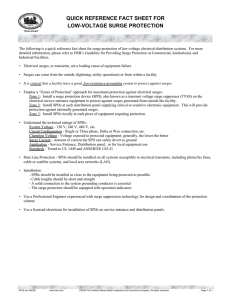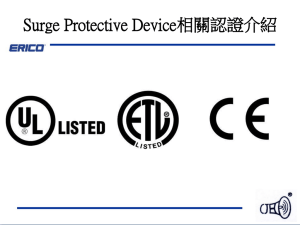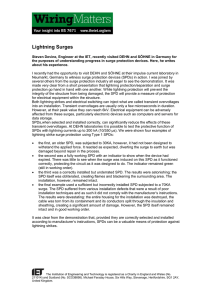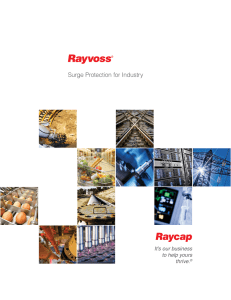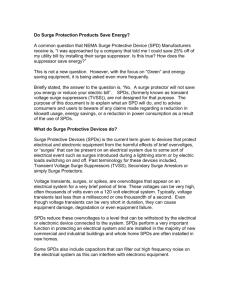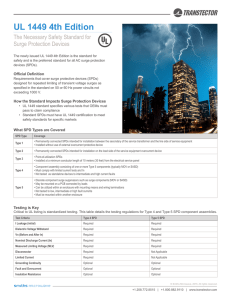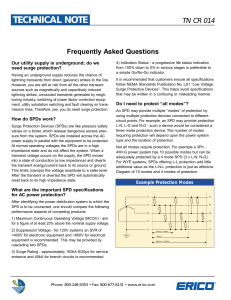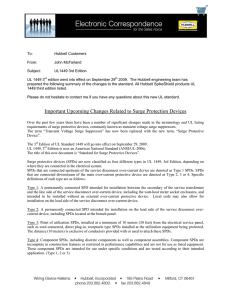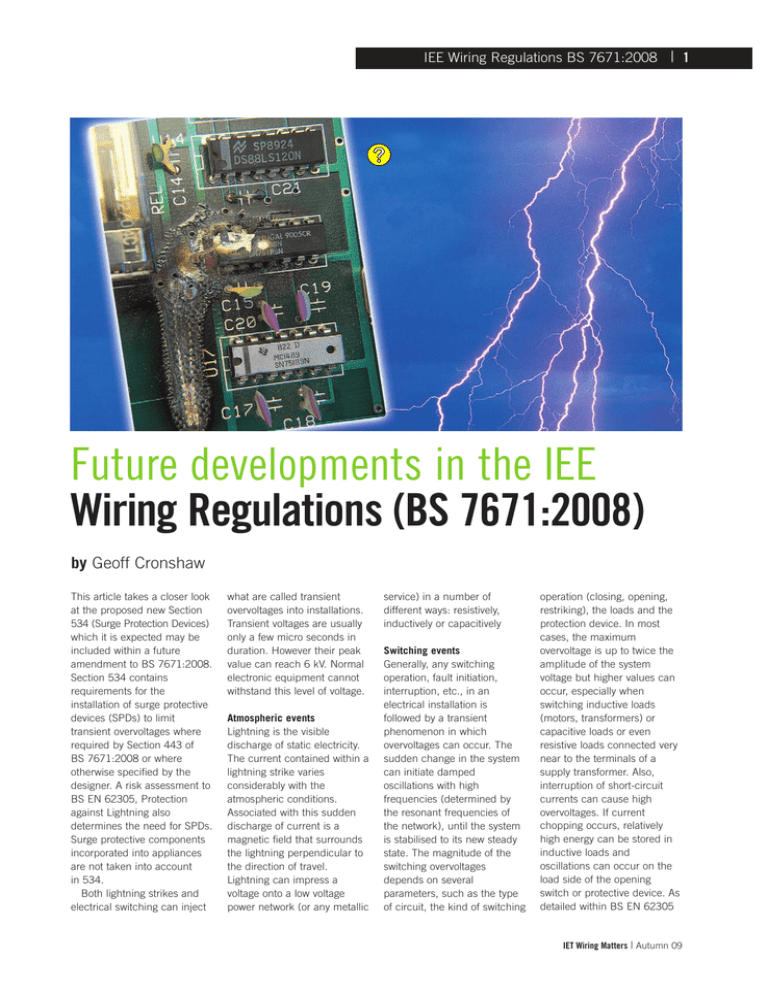
IEE Wiring Regulations BS 7671:2008 | 1
Future developments in the IEE
Wiring Regulations (BS 7671:2008)
by Geoff Cronshaw
This article takes a closer look
at the proposed new Section
534 (Surge Protection Devices)
which it is expected may be
included within a future
amendment to BS 7671:2008.
Section 534 contains
requirements for the
installation of surge protective
devices (SPDs) to limit
transient overvoltages where
required by Section 443 of
BS 7671:2008 or where
otherwise specified by the
designer. A risk assessment to
BS EN 62305, Protection
against Lightning also
determines the need for SPDs.
Surge protective components
incorporated into appliances
are not taken into account
in 534.
Both lightning strikes and
electrical switching can inject
what are called transient
overvoltages into installations.
Transient voltages are usually
only a few micro seconds in
duration. However their peak
value can reach 6 kV. Normal
electronic equipment cannot
withstand this level of voltage.
Atmospheric events
Lightning is the visible
discharge of static electricity.
The current contained within a
lightning strike varies
considerably with the
atmospheric conditions.
Associated with this sudden
discharge of current is a
magnetic field that surrounds
the lightning perpendicular to
the direction of travel.
Lightning can impress a
voltage onto a low voltage
power network (or any metallic
service) in a number of
different ways: resistively,
inductively or capacitively
Switching events
Generally, any switching
operation, fault initiation,
interruption, etc., in an
electrical installation is
followed by a transient
phenomenon in which
overvoltages can occur. The
sudden change in the system
can initiate damped
oscillations with high
frequencies (determined by
the resonant frequencies of
the network), until the system
is stabilised to its new steady
state. The magnitude of the
switching overvoltages
depends on several
parameters, such as the type
of circuit, the kind of switching
operation (closing, opening,
restriking), the loads and the
protection device. In most
cases, the maximum
overvoltage is up to twice the
amplitude of the system
voltage but higher values can
occur, especially when
switching inductive loads
(motors, transformers) or
capacitive loads or even
resistive loads connected very
near to the terminals of a
supply transformer. Also,
interruption of short-circuit
currents can cause high
overvoltages. If current
chopping occurs, relatively
high energy can be stored in
inductive loads and
oscillations can occur on the
load side of the opening
switch or protective device. As
detailed within BS EN 62305
IET Wiring Matters | Autumn 09
2 | IEE Wiring Regulations BS 7671:2008
“Protection against lightning”,
surges present a risk of
dangerous sparking or
flashover leading to possible
fire and electric shock
hazards. Surges also present
risk of disruption, degradation
and damage to electrical and
electronic equipment leading
to costly system downtime.
Surge Protection Devices
A surge protective device
(SPD) is a device that is
intended to limit transient over
voltages and divert damaging
surge current away from
sensitive equipment. SPDs
must have the necessary
capability to deal with the
current levels and durations
involved in the surges to be
expected at their point of
installation.
Installation of a surge protective device
SPDs can operate in one of
two ways, based on the
component technologies
within them. One way is as a
voltage switching device where
under normal conditions, the
device is an open circuit.
However at a certain threshold
voltage the SPD conducts and
diverts the current through it.
It has two states ON and OFF,
hence the name of voltage
switching. Air gap technology
is an example of a voltage
switching device.
Another way is as a voltage
limiting device. Voltage limiting
type SPDs again present
an open circuit under normal
circuit conditions. When an
over voltage is detected the
device begins to conduct,
dropping its resistance
dramatically such that the
overvoltage is limited and the
surge current is diverted away
from the protected equipment.
Metal Oxide Varistors (MOVs)
are a common example of
voltage limiting devices.
Advanced SPDs often utilise
hybrid technologies combining
voltage switching with voltage
limiting components.
Selection of SPDs
Section 534 contains
requirements for the selection
of SPDs in order to ensure that
the correct type of SPD is
installed at the correct position
within an installation. Typically,
Type 1 SPDs are used at the
origin of the installation, Type 2
SPDs are used at distribution
boards and Type 3 SPDs are
used near terminal equipment.
Combined Type SPDs are
classified with more than one
Surge
Equipment
SPD
Surge
(close)
Normal
(open)
Schematic diagram showing
the basic principle of operation
of a surge protective device
Type, e.g. Type 1+2, Type 2+3.
Type 1 SPDs are only used
where there is a risk of direct
lightning current.
Section 534 advises that in
selecting an SPD, the key
parameter is its limiting
voltage performance
(protection level Up) during
the expected surge event.
The SPD energy withstand
(e.g Iimp) also needs to be
sufficient for its location within
the installation. An SPD with a
low protection level will ensure
adequate protection of the
equipment, while an SPD with
a high energy withstand may
only result in a longer
operating life. All SPDs are to
comply with BS EN 61643.
Connection of SPDs
Section 534 contains a
number of requirements for
the Connection of SPDs
depending on the type of
supply and system earthing.
BS 7671:2008 lists five
types of earthing system:
TN-S, TN-C-S, TT, TN-C,
and IT.
T = Earth (from the
French word Terre)
N = Neutral
S = Separate
C = Combined
I = Isolated (The source of an
IT system is either connected
to earth through a deliberately
introduced earthing impedance
or is isolated from Earth. All
exposed-conductive-parts of an
installation are connected to an
earth electrode.)
When designing an
electrical installation, one of
the first things to determine is
the type of earthing system.
The distributor will be able to
provide this information.
The system will either be
TN-S, TN-C-S (PME) or TT for
a low voltage supply given in
accordance with the Electricity
Safety, Quality and Continuity
Regulations 2002. This is
because TN-C requires an
exemption from the Electricity
Safety, Quality and Continuity
Wiring Matters is produced by IET Services Limited, a subsidiary of The Institution of Engineering and Technology (IET), for the IET.
Michael Faraday House, Six Hills Way, Stevenage, Herts, SG1 2AY, United Kingdom Tel: +44 (0)1438 313311 Fax: +44 (0)1438 313465
Advertising Sales D Smith +44 (0)1438 767224 daniellesmith@theiet.org | Editor G D Cronshaw +44 (0)1438 767384 gcronshaw@theiet.org |
Contributing Editors M Coles, J Elliott, P Bicheno| Design Sable Media Solutions
IEE Wiring Matters is a quarterly publication from the Institution of Engineering and Technology (IET). The IET is not as a body responsible for
the opinions expressed.
©2009: The Institution of Engineering and Technology. All rights reserved. No part of this publication may be reproduced, stored in a retrieval system, or transmitted in any form
or by any means without the permission in writing of the publisher. Copying of articles is not permitted except for personal and internal use. Multiple copying of the content of
this publication without permission is always illegal. Web-offset printing by Wyndeham Heron, The Bentall Complex, Colchester Road, Heybridge, Maldon, Essex, UK
Postage/Handling: Postage within the UK is £3.50 for any number of titles. Outside UK (Europe) add £5.00 for first title and £2.00 for each additional book.
Rest of World add £7.50 for the first book and £2.00 for each additional book. Books will be sent via airmail. Courier rates are available on request, please call
+44 (0) 1438 767328 or email sales@theiet.org for rates.
Co-operating Organisations The Institution of Engineering & Technology acknowledges the contribution made by the following organisations in the preparation of
this publication: British Electrotechnical & Allied Manufacturers Association Ltd – P D Galbraith, M H Mullins | Department for Communities and Local Government –
I Drummond | Electrical Contractors Association – D Locke, S Burchell | City & Guilds of London Institute – H R Lovegrove | Electrical Contractors Association of Scotland
SELECT – D Millar, N McGuiness | Health & Safety Executive – K Morton | Electrical Safety Council | ERA Technology Limited – M Coates, A Finney
| Consultant - A Rufaie | Dept of Health - C Holme | British Cables Association – C Reed | Scottish Building Standards Agency | Department for Business, Enterprise
and Regulatory Reform | GAMBICA – M Hadley, A. Sedhev | Lighting Association – L Barling | ISSN 1749-978-X
IET Wiring Matters | Autumn 09
PWRRFP93
4 | IEE Wiring Regulations BS 7671:2008
Regulations, and an IT system
is not permitted for a low
voltage public supply in the
UK because the source is not
directly earthed. Therefore
TN-C and IT systems are both
very uncommon in the UK.
Therefore, for example,
Section 534 requires that
SPDs at or near the origin of
the installation (if there is a
direct connection between the
neutral conductor and the
protective conductor at or
near the origin) shall be
connected between each line
conductor and the protective
conductor/main earthing
terminal which ever is the
shorter distance.
Clause 534.2.3 of the proposed
Section 534 selection of Surge
Protective Devices (SPDs)
Clause 534.2.3 requires that
SPDs shall be selected in
accordance with the following
requirements:
• voltage protection level (Up)
• continuous operating
voltage (Uc)
• temporary overvoltages (TOVs)
• nominal discharge current
(Inspd) and impulse current
(Iimp)
• prospective fault current
and the follow current
interrupt rating
Co-ordination of SPDs
Occasionally it may be required
to limit the voltage to the
protected equipment to an
even lower value. In this case
two SPDs are used in a
co-coordinated approach to
minimise the let-through voltage.
Protection against overcurrent
and consequences of SPDs
end of life
Clause 534.2.4 has
requirements for the
protection against SPD shortcircuits by Overload Circuit
Protective Devices.
Fault protection integrity
Clause 534.2.5 has
IET Wiring Matters | Autumn 09
requirements to ensure that
fault protection, shall remain
effective in the protected
installation even in case of
failures of SPDs.
SPD installation in
conjunction with RCDs
An RCD is a protective device
used to automatically
disconnect the electrical supply
when an imbalance is detected
between live conductors. In the
case of a single-phase circuit,
the device monitors the
difference in currents between
the line and neutral
conductors. If a line to earth
fault develops, a portion of the
line conductor current will not
return through the neutral
conductor. The device monitors
this difference, operates and
disconnects the circuit when
the residual current reaches a
preset limit, the residual
operating current (IΔn). An
RCD on its own does not
provide protection against
overcurrents. Overcurrent
protection is provided by a fuse
or a circuit-breaker. However,
combined RCD and circuitbreakers are available and are
designated RCBOs. Unwanted
tripping of RCDs can occur
when a protective conductor
current or leakage current
causes unnecessary operation
of the RCD. An RCD must be
so selected and the electrical
circuits so subdivided that any
protective conductor current
that may be expected to occur
during normal operation of the
connected load(s) will be
unlikely to cause unnecessary
tripping of the device.
Discrimination: Where two, or
more, RCDs are connected in
series, discrimination must be
provided, if necessary, to
prevent danger. During a fault,
discrimination will be achieved
when the device electrically
nearest to the fault operates
and does not affect other
upstream devices.
Discrimination will be
achieved when ‘S’ (Selective)
types are used in conjunction
with downstream general type
RCDs. The ‘S’ type has a builtin time delay and provides
discrimination by simply
ignoring the fault for a set
period of time allowing more
sensitive downstream devices
to operate and remove the
fault. For example, when two
RCDs are connected in series,
to provide discrimination, the
first RCD should be an ‘S’
type. RCDs with built in time
delays should not be used to
provide personal protection.
Clause 534.2.6 of Section
534 is concerned with ensuring
that the correct type of RCD is
selected in conjunction with the
correct type of SPD. Where
SPDs are installed on the load
side of an RCD, the operation of
the SPD could potentially cause
the RCD to operate unless it is
of the S type. Where SPDs are
installed on the supply side of
an RCD the operation of the
SPD will not affect the RCD.
Clause 534.2.6 states:
Where SPDs are installed in
accordance with 534.2.1 and
are on the load side of a
residual current device, an
RCD with or without time delay,
but having an immunity to
surge currents of at least 3kA
8/20, shall be used.
NOTE 1: S-type RCDs satisfy
this requirement.
NOTE 2: In the case of surge
current higher than 3 kA 8/20,
the RCD may trip causing
interruption of the power supply.
SPD status indication
Section 534 requires indication
to be provided by a status
indicator local to the SPD itself
and/or remote, that the SPD no
longer provides (or provides
limited) overvoltage protection.
Critical length of
connecting conductors
To gain maximum protection
the supply conductors shall be
kept as short as possible, to
minimise additive inductive
voltage drops across the
conductors. Current loops shall
be avoided. Clause 534.2.9 has
specific requirements on
conductor lengths.
Cross-section of
connecting conductors
Clause 534.2.10 states:
The connecting conductors of
SPDs shall either:
i) have a cross-sectional area
of not less than 4 mm2 copper
(or equivalent) if the
cross-sectional area of the line
conductors is greater than or
equal to 4 mm2, or
ii) have a cross-sectional area
not less than that of the line
conductors, where the
line conductors have a
cross-sectional area less
than 4 mm2.
Where there is a structural
lightning protection system, the
minimum cross-sectional area
for Type 1 SPDs shall be
16 mm2 copper, or equivalent.
Further information
Important: this article is only
intended as a brief summary
of possible forthcoming
requirements in BS 7671.
Persons involved in this
area should seek specialist
advice. For further information
on the installation of surge
protective devices see
HD 60364-5-534.
Conclusion
Section 534 may or may not be
included in amendment
number 1 of BS 7671:2008
depending on the decision of
the National Wiring Regulations
Committee (JPEL/64). A future
amendment to the IEE Wiring
Regulation (BS 7671:2008) is
expected during 2011.
Acknowledgements
Thanks to Furse, Hager and
Schneider Electric for some of
the images and information
contained in this article. n
PWRRFP93

